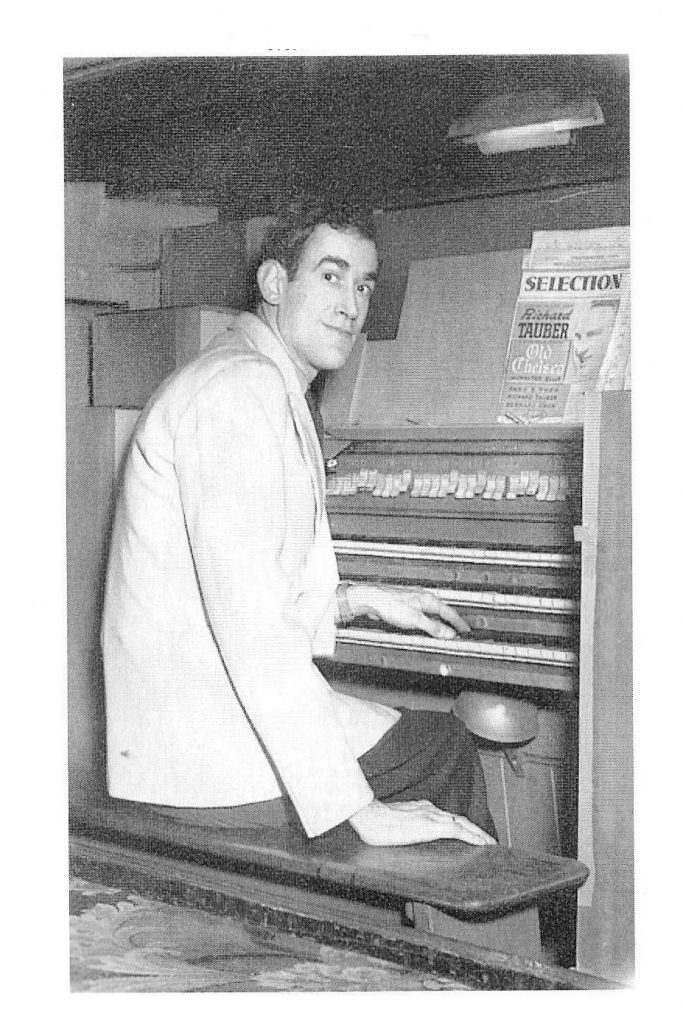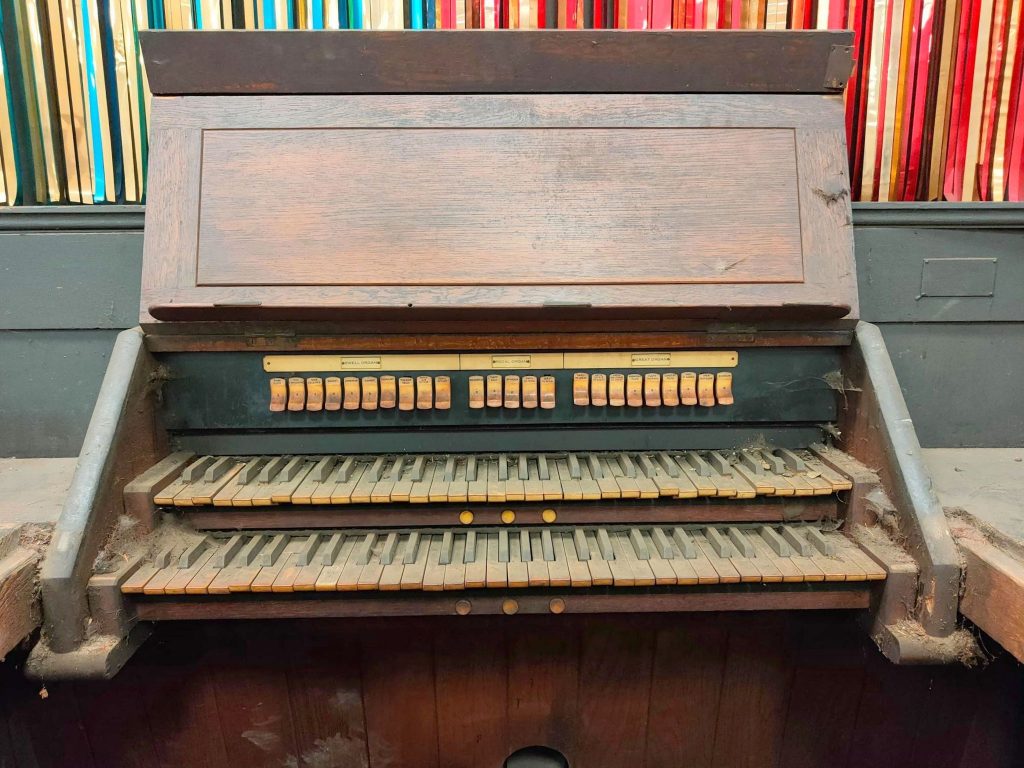The Orchestral Organs

Conacher Orchestral Theatre Organs
Born in Scotland in 1823, Peter Conacher learnt his trade during several years in Europe. On his return to England he found employment with Hill & Sons, then J W Walker & Sons before, in 1854, establishing the company which was to bear his name for over a century, Peter Conacher & Co. Initially based in George St, Huddersfield, the Company moved to Springwood Works in Water St in 1873. These premises were fully equipped and Conachers produced in excess of 25 instruments annually for halls, churches and other venues. The years following the First World War constituted a period development for the company. Aware of the potential cinema market, two instruments were constructed and installed.
On 2nd October 1916, The Lounge cinema opened on North Lane in the Leeds suburb of Headingley. With 483 seats it was of modest size but it was three years before an organ was purchased. In 1919, a 3 manual Conacher, Job No 1558, was installed in two chambers. Opened by Leopold Jackson, details of it are scant. It is likely that it fell into disuse with the coming of sound in the late 1920s, struggling to compete with the modern unit instruments installed in Leeds’ more prestigious cinemas. In 1952 it was removed for scrap. The Lounge was substantially rebuilt in 1999, but closed in 2005. Demolition followed in 2012, although the facade has been retained in the apartment block now occupying the site.
More is known about the second Conacher installed that year. The Empire, in Oldham’s Waterloo St, opened as a live theatre in 1897, later becoming a full-time cinema, seating 1534. Conacher obtained a contract and in 1919, Job No 1565, a 3 manual instrument with 21 Speaking Stops was installed. At a reported cost of £2215, the specification included a Bass Drum, Kettle Drum, Cymbals, triangle and an 18-note set of Tubular Bells. Records do not show when this Conacher fell into disuse or what happened to it. The Empire Picture House, as it was later known, ceased film exhibition in 1969 and was demolished in 1981. The organ may have remained, been disposed of earlier or, most likely sold for scrap.
Two more orders were despatched in the following year, 1920. Job No 1554 was an instrument of 3 manuals and 21 Speaking Stops. Like its fellows it had a fixed console. Haydn Harper Sandwell FRCO, Assistant Organist at Huddersfield Parish Church and Music Master at St James Grammar School, Huddersfield presided at its opening in a theatre which had already been operating for a number of years, the Picture House at 19 Ramsden St, Huddersfield. This had opened on 26th December 1916, with 600 seats, later increased to 873 by the addition of a balcony. As the nearest installation to the Conacher works, a little local knowledge may have helped secure the order. The cinema was taken over by Essoldo in October 1957, remaining open until June 1967 when a Compulsory Purchase Order saw it demolished for town centre improvements. The Conacher stayed until the bitter end, its final journey taking it to the scrapyard.
Harrogate was the destination for the second cinema installation of the year, Job No 1570 finding its way to the new Central Cinema, Oxford St. Another instrument of 3 manuals, it was opened on 31st July, 1920 by William Elbourne, sometime organist and choirmaster of Knaresborough Parish Church, who moved on to become a cinema organist, before taking holy orders. The Central opened with seating for over 900 and a Proscenium width of 25 feet. Publicity proclaimed, “…full orchestral music with the accompaniment on the Grand organ, installed at a cost of £3,300.” (Harrogate Advertiser, 25th January 2006, ‘Musical entertainment in golden age of cinema.’) In 1929 it became the first cinema in town to be equipped with sound. Absorbed into the Marks Cinema Circuit of Manchester in 1947 it remained operational for a further two years; ‘Bohemian Girl’ starring Laurel and Hardy being the final film shown on 20th August 1949. The Conacher was removed in 1955 to the church of St John the Divine, Rastrick. Modified, it remains in regular use. As it has been surveyed for the NPOR, details exist at http://www.npor.org.uk/NPORView.html?RI=R01135. After closure, the Central become a furniture store. When this closed in 1961, it was demolished. The church’s website at http://www.stjohnsrastrick.org.uk/music contains photographs of the instrument as it is today. Perhaps a hint of its past life lies in the presence of the two tremulants; not always retained when an entertainment instrument decamps to hallowed grounds.
In 1921 Conachers fulfilled orders for two northern halls. The Coliseum, Spital Hill, Sheffield opened on 24th April, 1913 with 1400 seats. Eight years later, the Directors placed an order for Job No 1571. Costing £2060, it was a 3 manual 27ss instrument. The organ was divided, with pipework in chambers either side of the stage and was opened by David Clegg. A popular recitalist, Clegg (1867-1923) had been organist of Littleborough Parish Church, Manchester and Salford Borough Organist from 1907. He seems to have attracted a good press wherever he performed. The Aberdare Recorder of 11th October, 1913 noted, “Mr David Clegg has now given over 3000 recitals in the Principal Public Halls in the United Kingdom and is well known on the Continent.” going on to report that Clegg had distinguished himself in America, performing “…before President Roosevelt and Officers of the Armed Cruisers.”
Despite this auspicious beginning, the organ soon faded from view. It was taken from the cinema in 1935 after only 14 years, modified and re-installed in South Anston Methodist Church, where it remained until 1987. “The console was placed opposite the pulpit with the speaking pipes behind the pulpit. It was difficult to play as there was a considerable delay between playing a note and the sound being produced. The present organ, taken from a Methodist Church in Howden, Yorkshire, was installed in December 1970.” Beyond, nothing more is known about it. The Coliseum closed on 2nd November 1963 and was demolished two years later.
In 1913 Wakefield Picture House Ltd constructed The Picture House on Westgate. Costing £13,000, with 1400 seats it became the home of Job No1579, Conacher’s second cinema installation of 1921. This instrument of 3 manuals and 23 Speaking Stops was also opened by David Clegg. The Picture House, re-named Playhouse, was the first cinema in Wakefield to be equipped for sound. Eventually acquired by Classic Cinemas, it showed films until the 1980s. After closure it was used for skateboarding, then as a club. Today it survives as nightclub and bar. Internally re-constructed, the exterior has been sympathetically restored retaining the name ‘Picture House’. An article in a COS Journal, by George Foster, one-time resident organist implied it was scrapped, but still in the cinema. It is a remote possibility that the majority of the instrument might still be in situ.

Nothing for the cinema emerged from Springwood Works in 1922, but an instrument bearing the Conacher name was installed in The Palace cinema, Market Place, Long Eaton during that year. To avoid confusion, it must be considered. Conacher, Sheffield and Co, Organ Builders, was based in Birmingham, but had no connection with Peter Conacher & Co. It was chosen by the management of The Palace to provide a 2 manual organ with 10 Speaking Stops, Chimes and Percussion, installed in the Orchestra Pit. The Palace opened as a live theatre on 12th July 1912, but changed over to silent film exhibition. Sound was installed in 1931 and during March 1936 it was renamed the Ritz. It closed in 1983, had several reprieves and finally closed in 1996. The building now functions as a Bar and Club, known as ‘The Box Office’.
As installed, the organ was not complex. The Great had Open Diapason, Muted Cello, and Clarinet at 8′ pitch; Gedakt at 4′ and Piccolo at 2′. The Solo contained Como Flute, Oboe, Vox Humana, Viol d’Orchestre and Aeoline: all at 8′ pitch. Two tremulants and a set of Tubular Chimes were present, whilst the Pedal Organ contained 16′ Bourdon, 8′ Bass Flute and Drum. Several couplers allowed the organist some flexibility. It was removed to Broomhill Methodist Church, Bulwell, near Nottingham. Around 2003 it was removed and is presumed scrapped.
The next cinema organ produced by Conachers was delivered to the Picture House at 210 Great North Road, Woodlands near Doncaster. Opening in the 1920s, it boasted an adjoining Billiard Hall. The 1927 Kine Year Book records admission prices as 4d to 1/-. Film exhibition ceased in the 1970s. The building survived as now closed, Woodlands Bingo Club and Woodlands Snooker Club. Costing £1,200, Job No 1626 was installed in 1923. It is still there, the fixed console emerging from beneath the floorboards during recent internal works, whilst the pipework remains in its chamber, boarded in during the 1930s.

(Caution must be exercised to avoid confusion with the Picture House, opened in 1914 in Doncaster’s High St. This opened with a 2 manual Walker organ, formerly installed in a church. Following a period on Bingo, this Picture House was demolished in 2003.)
The Grand Theatre, North Bridge, Halifax, with interior by Frank Matcham, opened on 5th August 1889. This 1000-plus seater offered Variety with, later, films during the Summer Season. In 1925 it became a full-time cinema, re-named The Grand Picture House, opening with Mae Bush in ‘The Lady Secretary’. A Conacher of 3 manuals and 24 Speaking Stops was installed, leaving the factory as Job No 1632. Made redundant by the coming of sound, the organ was removed, presumably it was scrapped. The Grandclosed as a cinema in the early 1950s, but was briefly used as a Repertory Theatre. Final closure came in 1956 with demolition the following year.
Conacher, in 1927, installed the last of their orchestral cinema organs in the City Cinema at 54, Bridge St, Peterborough. The City opened on 27th March, with seating for around 1200. With a 26 foot wide Proscenium and 40 foot deep stage, it boasted 4 dressing rooms, a Cafe and Dance Hall. Job No 1649 was a large instrument with fixed console, 4 manuals and 30 Speaking Stops. The pipework was in 2 chambers. Cooper Francis, later Organist and Master of Choristers at Peterborough Cathedral, and a G Rhodes were the organists for this occasion.
During 1942, the City Cinema was struck by a German incendiary bomb which caused considerable damage and destroyed the organ. Rebuilt, it closed during the 1950s and was demolished in 1961.
One instrument has so far proved elusive as I have been unable to discover any details about it. A Conacher was installed in thenow demolished Grand Cinema, Failsworth. If anyone can provide information, we would be very grateful.
